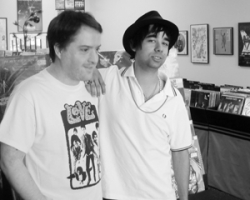Geoff Leamon’s business strategy may seem like the wishes of a romantic dreamer.
After more than 20 years working in the music industry as everything from a member of rock bands to music promotions and production, Leamon decided to follow his muse and open a record store.
Yes, readers, we meant to say records, as in the type made from vinyl that many music fans believe has gone the way of the proverbial dodo bird. Leamon’s theme is records, not compact discs, although you can get those as well at Leamon’s Left of the Dial Record Store.
The shop, at 1065 Pacific Coast Highway, is new to Seal Beach. It sells an eclectic collection of new and used records.
While the hey-day of vinyl and analog recording and distribution seems obsolete, Leamon said the story of Long Playing albums and even 45s is still unfolding.
Leamon carries used records, but not all of his merchandise items are antiques.
In fact, Leamon said he stocks new versions and copies of some new and many of the older and classic LP recordings.
“Vinyl is coming back,” Leamon said. “There is something warm about the sound of a vinyl record versus digital recordings. Compact discs can often sound tinny.”
According industry standards, Long-playing record albums are 33 1/3 rpm (rotations per minute), typically vinyl, gramophone records (phonograph records), generally either 10 or 12 inches in diameter.
They were introduced unsuccessfully by RCA in 1931 and successfully by Columbia in 1948, and served as a primary release format for recorded music until the compact disc began to significantly displace them in the 1980s.
In the 21st century, a renewed interest in vinyl has occurred and the demand for the medium has been on a steady increase yearly in niche markets.
The long-playing record is an analog format.
Analog recording methods store audio signals as a continual wave in or on the media. The wave might be stored as a physical texture on a phonograph record, or a fluctuation in the field strength of a magnetic recording.
This is different from digital recording, which converts audio signals into discrete numbers.
The first successful demonstration of analog recording for audio was by Thomas Alva Edison. To service the resurgence of vinyl recordings, Leamon also sells state of the art turntables.
Yes folks, they are making new ones.
In fact they can play LP and 45 records better than ever, Leamon said.
Meanwhile, the artwork and images that appear on album covers in Leamon’s store throughout the years represent a cultural journey.
Musicians, songwriters and performers appear on the album covers, creating a tapestry of ever evolving tastes for various music genres.
They also tell the story of a society in flux and offer a visual feast and a journey through the past.
You can also find classic jazz and blues recordings at Left of the Dial Records.
Since opening his store in November, Leamon said it has begun to create a stir.
He said that baby boomers and teenagers have flocked to the shop.
“We already have some regular customers from the local area who like to come in and browse our shelves,”
Leamon’s store stocks many classic albums from the golden age of rock ’n roll to the British invasion, through the day of flower power and hippies to more modern groups such as grunge rock pioneers Nirvana.
Leamon, who hails from northern California, said he moved to the Southland with his wife Jenni so they could be near family.
He said he is glad he chose the eclectic town of Seal Beach to launch his business.
“I saw it as the golden opportunity to do my own thing in the music industry,” Leamon said.
For more information, call Left of the Dial Records at (562) 598-3666, or visit the shop at 1065 Pacific Coast Highway, Seal Beach (in the Pavilion’s shopping center).





